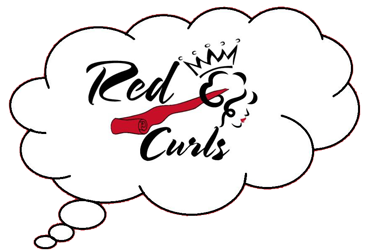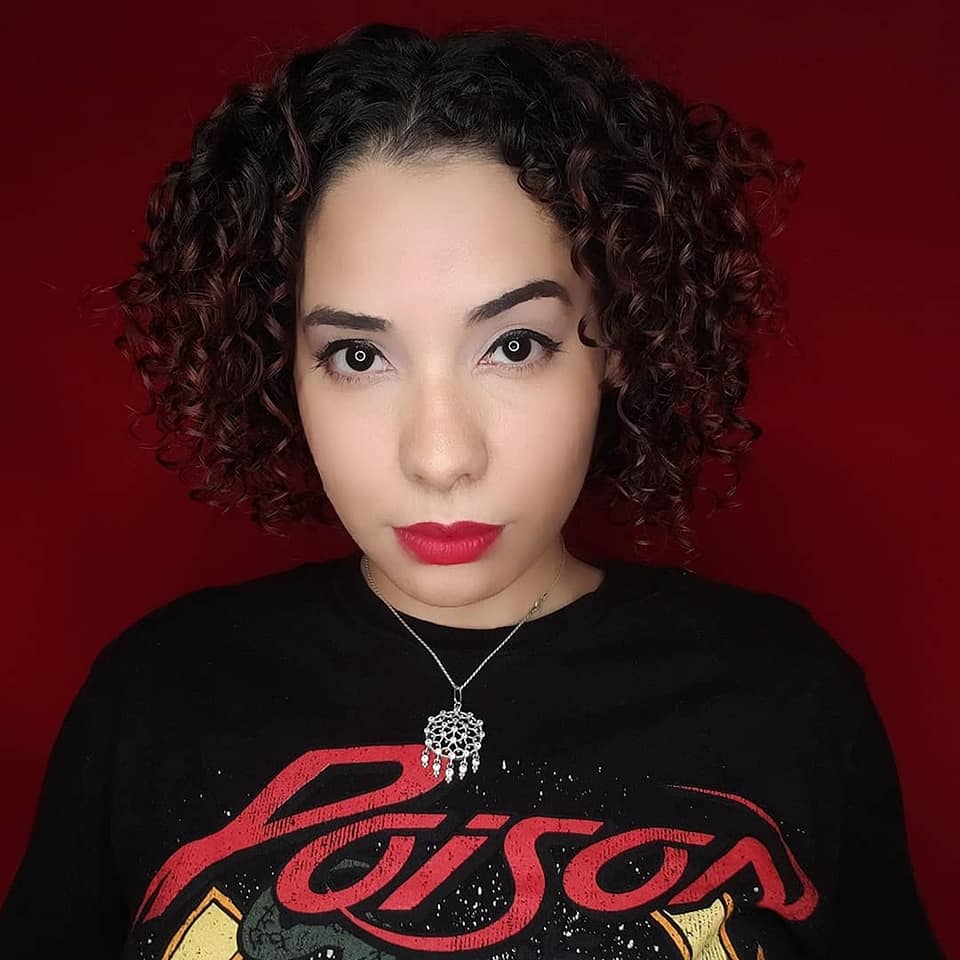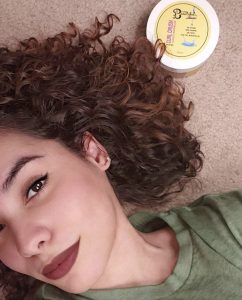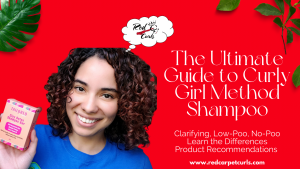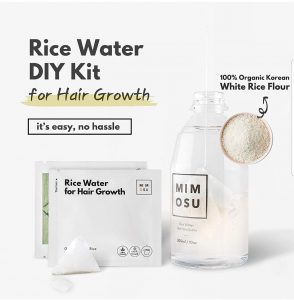Finding the right washday routine is all trial and error, let’s be honest. Most of us will go through many, and I mean MANY different products before finding what works for us. I decided to write out my standard washday routine in depth, in hopes that it will help others build their own routine.
One of the first mistakes I ever made, was scouring Youtube for curly hair gurus. Many times those YouTubers did not follow the curly girl method so many of their product recommendations were a no-go for me. If I did find Youtubers that followed the curly girl method the next mistake I would make was following advice that wouldn’t work for my hair type. So, my first piece of advice before reading this washday routine example is to find out what your hair type is first. This will save you many headaches and wasted dollars down the drain later.
My hair type is:
- Fine
- 3a/3B Curl Pattern
- High Porosity
Since my hair is fine and I started out with a lot of heat damage as you can tell from this photo:

Shampoo:
So from the very beginning, I realized the strict curly girl method (co-washing only, never using shampoo) was just not for me. The reason is, conditioners deposit moisture into your hair. The chemistry can get pretty tricky, but if you are interested in the science behind what co-washing does definitely check out the co-wash article. Over time, as you continue co-washing, the conditioner is going to continue depositing more moisture in your hair, which will weigh the hair down more over time. Also, if you are not correctly massaging the scalp with your fingertips or a scalp brush when you wash, the conditioner can build up on your scalp causing irritations or itchy flaky scalp. In extreme cases, the conditioner can buildup on the scalp clogging hair follicles and eventually causing hair loss.
After watching a couple of Instagram Q&A sessions done by Inahsi Naturals Founder Rhonda Marshall, I realized science was the way to go on unlocking the secrets to my hair. Rhonda Marshall is not only the founder of one of my favorite all natural small business brands, but she is also a chemist and educator! So, I knew her info was going to put me on the right track. Ms. Marshall ended up explaining that your scalp needs to be shampooed at least once a month. As I already mentioned, the hair will become weighed down with only conditioners, and the build-up on the scalp can lead to other annoying issues. The shampoo works to strip the hair of any buildup including sweat, oil, silicones, etc. This strips all the layers of products and oils you have used during the week or last few weeks completely giving you a fresh start. Often frizz is caused by not clarifying or using shampoo as often as we should.
Normally, I like to use moisturizing shampoos like Shea Moisture Manuka Honey and Mufura Oil Intensive Hydration Shampoo (available in Walmart, Target, and Amazon for quick purchases) or Tailored Beauty Coconut Creme Shampoo. For this specific washday (March 4, 2019), I decided to go with an old favorite, Woman to Woman Naturals Gorgeous Collection Hair Cleanser. The company advertises the cleanser as “removing build-up and cleanses all hair types by infusing elderflower, red clover, aloe vera and chamomile among other natural ingredients. ” Off the bat, I am met with all natural and moisturizing ingredients that will help cleanse my hair and moisturize it at the same time. The shampoo does foam a bit but not much and it does give that dry hair feeling many sulfate shampoos gave us in the past, but that is quickly gone once I apply conditioner or deep conditioner. With the help of a scalp brush, my scalp always feels thoroughly clean once rinsed off.

I love using a simple scalp brush to help me effectively cleanse my scalp. Did you know the top layer of your scalp is actually keratinized (hardened) cells? Throughout the day, the flakes basically fall out themselves without you knowing. If you are struggling with excessive flaking a.k.a dandruff it can be an indication that it is time to focus on massaging and scrubbing a bit more. The worst way to scrub your scalp is with your fingernails. The fingernails can scrape and irritate the scalp. The scalp brush works to deeply cleanse. As you slowly move the scalp brush back and forth on your head (Don’t move the brush in circular motions as it will cause tangles) any debris on your follicles will be removed. The brush also works to massage the scalp to increase blood flow to the scalp but gently scrubbing for you. I think it’s a great and inexpensive tool to have to make sure your scalp stays clean and balanced.
Apple Cider Vinegar Rinse
Many people like to use the apple cider vinegar rinse as a way to clarify hair as an alternative for using shampoo. You can absolutely do that! For me, I use it to solve my scalp issues. I struggle with flaky scalp as a result of not drinking enough water lately, so this is a perfect way to combat that.
Acv is naturally slightly acidic, so it serves as the perfect alternative to restore the natural ph level of the acid mantle (a very fine, slightly acidic film on the surface of human skin. It acts as a barrier to bacteria, viruses and other potential contaminants that might penetrate the skin.) When the acid mantle is exposed to the acidity of the apple cider vinegar, the mantle hardens the outer layer of the hair strand, this ultimately leads to the “scales” flattening, allowing hair to be more manageable and shiny. ACV has a PH balance of 2.9.
This is one of those treatments where measurements count. Too much ACV dries the hair out. I normally use about 2 tablespoons in a 16-ounce Poland Springs water bottle and shake. After I shampoo I lean my head back pour the mixture all over my scalp letting it flow down the scalp. I try to pay special attention to the spots of my scalp that flake the most. After there is no more left in the bottle, I gently massage my scalp with my fingertips. I leave the acv in my hair for about 3 minutes then rinse. The ACV is a natural conditioner and helps close the scales on the cuticle of your hair strands for a natural shine.
Deep Condition/Gentle Protein Treatment
Deep conditioning is vital to restoring the health of the hair. Since I do this extended washday once a week, I like to save some time and combine both these treatments. Deep conditioning should be done once a week. Deep conditioners are different from regular rinse out conditioners because the formulas contain ingredients that will penetrate the hair strand, strengthening the cortex (the innermost layer of the hair) of the hair which will increase the health and elasticity. Rinse out conditioners provide hydration and help smooth the cuticle( the outer most layer of the hair strand, also known as the surface) but they do not moisturize and repair as intensely as a deep conditioner since the ingredients are mild and its effects aren’t supposed to last for long.
Protein is a requirement for hair growth. Our hair consists of roughly 90% protein. Our hair sustains damage from everyday factors including your eating and hydration habits, the environment, and of course manipulation of hair such as brushes or high heating tools. Protein helps rebuild bonds in the hair to give curls their structure and be able to keep the shape. Fine hair especially needs protein more often. The key is finding the right kind of protein for hair. I choose amino acids because they are known as protein building blocks. Essentially broken down pieces of protein that are small enough to penetrate the hair shaft all the way to the cortex. If the cortex is strengthened then the rest of the strand will be strong as well and be able to hold your curls better. By utilizing amino acids (hydrolyzed proteins) the hair is able to increase its water retention levels, maintaining water in the hair for longer periods of time. This over time will lead to healthier, bouncier, and shinier looking hair.
To make everything easier I take two teaspoons of Bragg Natural Liquid Aminos also known as Soy Sauce Alternative (you can find it in your local supermarket) with whichever deep conditioner I am using that week. This week it happened to be the Mielle Organics Babassu Oil & Mint Deep Conditioner. I really like this deep conditioner because my hair always feels soft, balanced, and defined. I like to heat up my deep conditioners by either using the Q-Redew Hair Steamer or using a standing salon quality dryer, like this one I purchased at Sally’s Beauty. I put the dryer on low heat and sit under it for 30 minutes so the treatment has time to really penetrate and take full effect to give you the best results.
Styling
For styling, I decided to use the brand new Bemycurl The Mane Squeeze Leave-in Curl Primer. Personally, I think the name is pretty cool. Leave-in primer, similar to how we need a primer when we prepare to put on our makeup. The leave in primes your hair for the next step. One quick note I want to make about this particular product (video coming soon) the leave in when applied to the hair can begin drying up the water in the hair, so make sure to use pea-sized amounts (since it can be heavy) and keep a spray bottle around to help increase slip. I like to apply my products to sectioned (2 sections) soaking wet hair. I rake my products in careful making sure to switch to praying hands method for the ends. I switch techniques because the ends of the hair are the most susceptible to drying out and breaking off, so I pay special attention to them by ensuring there’s enough product on those areas.
Next, I apply the Let’s Get Kinky Hydrating Gel. The gel can actually be used without the leave in primer. The gel was formulated to be a one-step styling solution. While the leave in is great, if it doesn’t work for you, then just use the gel alone. I use nickel sized amounts at a time to build the hold I need. I rake in the gel the same way I did with the leave in and I when know the hair is saturated, I begin to gently scrunch upwards toward the scalp to encourage curl definition.
Most curly girls use microfiber towels or cotton t-shirts to scrunch excess water and product out of the hair to allow it to dry faster. I found microfiber towels took out far too much moisture from my fine high porosity hair. This often left me with frizz. The same results came with a cotton t-shirt. Instead, I use everyday kitchen paper towels to scrunch the excess product. I find the paper towels remove the perfect amount of moisture without disrupting the curls and causing frizz. It leaves me with frizz free definition every time.
I normally air dry for 30 minutes prior to going under the dryer. I like to give my hair time to form a gel cast to prevent frizzy and undefined curls later. I normally sit under the dryer for about 25-30 minutes and finish off with a quick 5 minute diffuse for extra volume.
Finally (yes, we made it!), I am a big believer in using oils…responsibly! I like to use 3-5 drops of jojoba oil to do a scalp massage and scrunch out the gel cast. I choose jojoba oil because it is the only oil that mimics human sebum(the scalp’s natural oils). This helps moisturize the scalps that do not produce enough of it and therefore increases dandruff. It also helps those who have oily scalps, the jojoba oil mimics sebum signaling to the scalp not to produce more sebum. Overtime jojoba helps regulate sebum secretion of the scalp for healthy and moisturized scalp and hair. Jojoba oil doesn’t have the same effect on the actual hair strands. Jojoba works as a sealant for natural hair, meaning it will not penetrate the hair strand. It will simply sit on top acting as a barrier preventing moisture from leaving the hair. This last step will help keep hair moisturized longer, especially important for high porosity hair. Any more than a few drops of oil for this step is too much. You should not be putting large amounts of oil or anything on your scalp as it can clog the follicles. In my experience 3-5 drops quickly absorbs into the scalp without leaving it greasy and leaving the hair weighed down.
